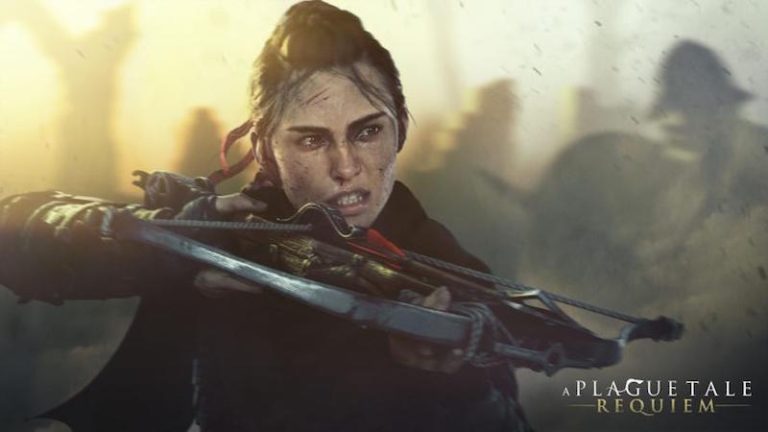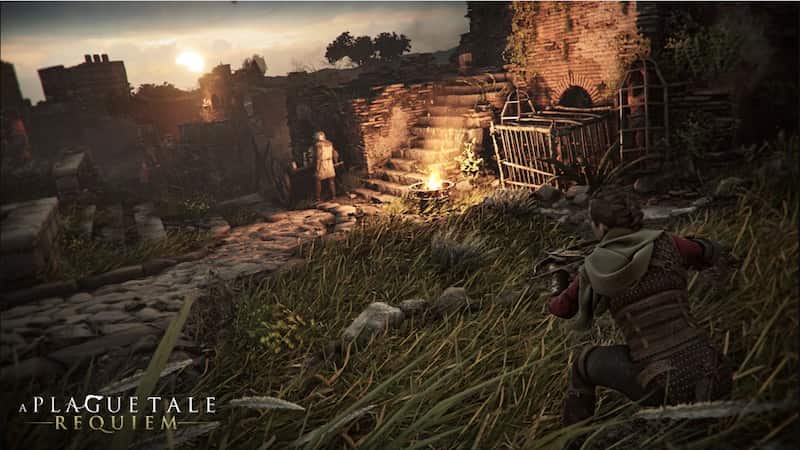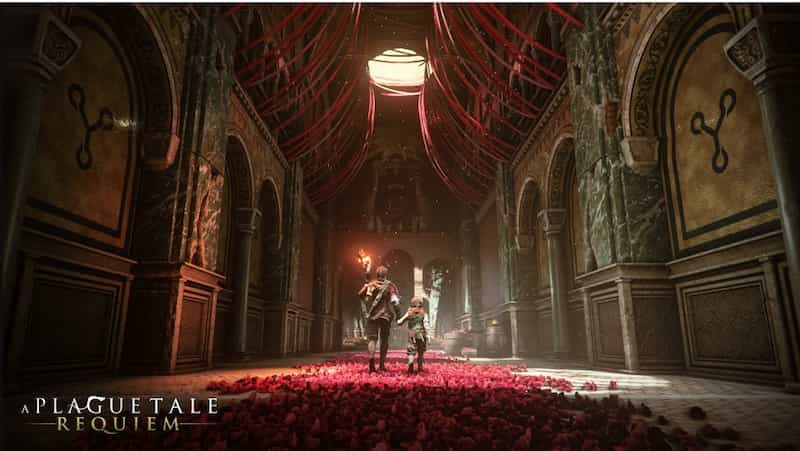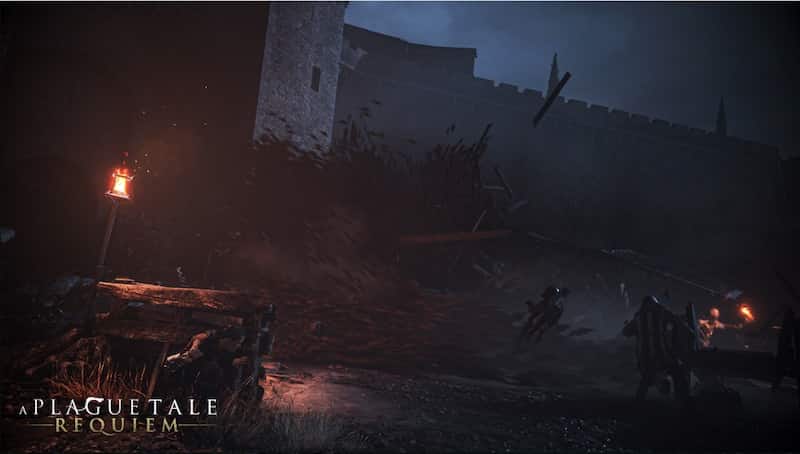A Plague Tale: Requiem PS5 Review. Asobo continues the story of Amicia and Hugo in A Plague Tale Requiem. Does it take their tale to new heights?
Whatever else you might end up thinking about A Plague Tale Requiem, you’ll not be able to deny that Asobo has put its all into it. An admirable swing for the fences in terms of scale, that’s bursting at the seams in trying to match its technical ambitions.
It’s a sequel so much bigger in every conceivable way that it genuinely feels like Asobo decided it would be better to not get things wrapped up in a third chapter in case it never got to happen and just went for it here.
A Plague Tale: Requiem Review (PS5) – Asobo Delivers A Bleak And Bewitching Sequel
A Tranquil Opening That Soon Descends Into Chaos
A Plague Tale Innocence should have been a clear sign of things to come. That’s a game that was shooting for the moon by sacrificing a few spare parts, and it was largely successful as a result with that caveat in mind. It managed to feel intimate and epic at the same time, but Requiem is Asobo doing its best to sacrifice nothing in order to deliver the true vision.
Asobo is certainly keen to show this from the off. Requiem follows the events of Innocence and brings us back into the cruel, plague-ridden world of alt-history 1300s France. The rats have gone, and siblings Amicia and Hugo are seemingly finding peace enough in the world to be playing together in the game’s sweet and serene opening. The world is more open now, with a breathtaking countryside view greeting you in these early moments.
The game gently teaches its refined stealth mechanics to you via a pretend play battle between Hugo, Amicia, and apprentice alchemist Lucas among the ruins of a castle. It’s a jarring sequence at first glance, almost feeling too on the nose as a setup for things going south. Now, at the other end of the story, I know to cherish these fleeting glimpses of contentment.
Yes, things do go sour not too long after this, and Amicia, Hugo, their mother Beatrice, and Lucas, soon find themselves back on the run and wading through a fresh outbreak of rat swarms. Hugo’s illness is starting to manifest once again, and Amicia finds herself in increasingly high-pressure situations in order to try and protect him.
To this end, Amicia is better equipped to deal with the barbaric human foes and flesh-stripping teeth of the rats in Requiem. Not only does the sling return, but a host of other options as well, creating a better balance and freedom between stealth and action. The best option is always to sneak wherever possible, but when pitched into battle, Amicia’s fate is far less black and white than before.
Stealth Is Your Best Friend, But Amicia Is Better Equipped This Time Around
She generally doesn’t get killed after a single attack and has some limited life-saving counters to get out of a jam. Whilst there are some instant death game overs in places, Requiem is much more willing to let you do things your way and keep the story moving.
The combat that is there is closer to the slow and nervy encounters of a survival horror than anything, and it’s a fantastic fit for Amicia who is strong and cunning for a girl of her age, but vulnerable in a physical sense when coming up against armored men. The David and Goliath act of slinging a rock at the soft meaty head of a soldier has all the impact it needs, thanks in part to the way the whoosh of the sling’s release cracks from the DualSense speaker whilst the controller’s haptics give a tactile sense of the pull and release.
The sling gets a bit of an upgrade in Requiem. There’s a growing list of things to coat rocks with from fire to tar to a potent ratnip that lures swarms away from your path. These substances can also be applied to quieter regular rock throws, crossbow bolts, and ceramic pots that give a greater spread of the substance’s effect. As the game progresses, there’s extra strategy levels to be discovered in how these things are combined with the environment and in using stealth.
Set piece segments aside, you rarely find Amicia engaging in a straight head to head fight, and instead often scramble about, moving from cover to cover in order to elude or to sneak up on enemies. While the combat encounters largely consist of the same patterns, the way you can approach them means they don’t wear out their welcome.
A Story Filled With Bloodshed And Hope
The story is constantly trying to reaffirm the hope that violence is not the answer, but rather than contradict itself via player freedom, the world consistently exposes that hope to be a lie. No matter how you might approach the ‘arena’ encounters with enemy soldiers, blood will eventually be spilled in the journey Amicia, Hugo, and friends make.
It actually does a great job of putting you in the mindset of its cast, who desperately want to be shot of war and bloodshed, but end up right back in it no matter how good their intentions may be. Requiem is a game of trying to find light in darkness both literally and metaphorically, and in both cases, that light can so easily be snuffed out by the relentless nature of the dark.
The cleverest thing the game does is offer up some uplifting dialogue or a captivating beauty of a landscape in service of the mantra that ‘things can only get better’ and it works, every damn time. It’s a vital point of reference for the story as a whole and I think it handles the topic of pursuing mass violence in the hope of personal peace more efficiently and earnestly than The Last of Part II managed.
I must admit, I did not expect a story of this length to be told in Requiem. Yes, it’s ‘only’ 15 hours long, but I wasn’t feeling a story of that length at the midway point, and ended up surprised when the game just continued beyond what I had thought to be the logical conclusion. That’s not to say there’s anything wrong with the story continuing beyond that point.
In fact, I think narratively, and in terms of set pieces, the last few hours are among the strongest in the entire length of Requiem. Yet it is a tricky thing to get used to at first, and does make a part of the game a bit of a drawn-out slog for patches when seen out of context.
Still, it makes it worth the time, and puts another notch in Requiem’s bow by telling a story that sprawls beyond the cosy confines of Summer in the countryside and into the kind of places that wouldn’t feel out of place in a From Software title. A Plague Tale Requiem gets so strange and messed up over the course of its playtime that it truly begins to feel like a descent through the circles of hell for Amicia and Hugo.
An Ambitious Sequel With A Few Technical Hiccups Along The Way
Once again, the drama and spectacle in A Plague Tale is serviced by a sublime score by Olivier Deriviere. Alongside familiar callbacks to Innocence’s ominous tones is a dreamlike choir arrangement that punctuates key moments with an almost religious fervor. Deriviere has already given us a sublime dynamic score for Dying Light 2 this year, but his score for A Plague Tale Requiem has an aching soul to it that makes it an instant addition to my favorite game soundtracks of this generation.
I admire the shot Asobo has taken in pushing this game as far as it can go, but I can’t say it gets away with it all the time. The game visibly suffers under the weight of its own technical ambition at times, and because Asobo has done such a fine job of punching above its weight, the moments the illusion is blurred feel all the more noticeable.
For me, it wasn’t a particularly buggy game, but the frame rate takes a hammering during certain moments of spectacle involving lots and lots of rats.
Another minor gripe I have is the controls. A Plague Tale Requiem handles fairly well overall, but there’s a real fiddly feeling interacting with character and objects. There’s a need to be in just the right position sometimes that caused more than a few problems when in time-sensitive situations. These are obviously things that will bother anyone precious about ‘consistency’ in game performance, but any game that can make these problems feel small is clearly doing something right, and A Plague Tale Requiem is one of those games.
It used to be that a sequel to a hit video game was almost always declared a superior entry. These days there’s almost always a debate about game sequels and whether they’re ‘better’ than the original or not for a variety of reasons. The biggest part of that is that modern sequels are usually setting such a high bar that when developers change what fans loved about the original, it becomes a point of contention that splits a fanbase.
A Plague Tale Innocence is a good game, clearly compromising to push certain front-facing aspects of itself. A Plague Tale Requiem had an open goal to aim for in terms of upping the ante from there, and Asobo has done so with some gusto.
A Plague Tale: Requiem is out on October 18, 2022 for PS5, PC, Nintendo Switch and Xbox Series X/S.
Review code kindly provided by publisher.
A Plague Tale: Requiem Guides:




